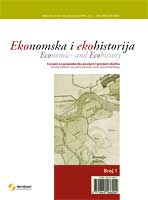ILIRIK U MARCELINOVOJ KRONICI
ILLYRICUM IN MARCELINE’S CHRONICLE
Author(s): Hrvoje GračaninSubject(s): History
Published by: Društvo za hrvatsku ekonomsku povijest i ekohistoriju - Izdavačka kuća Meridijani
Keywords: Comes Marcellinus; prefecture of Illyricum; diocese of Thracia; Huns; Ostrogoths; Bulgars; Slavs; natural disasters; depopulation; Illyrian military; Illyrian orthodoxy
Summary/Abstract: The author analyzes the data from the “Chronicle” of Count Marcellinus (6th century A.D.) relevant to the socio-economic history and ecohistory of the late antique Illyricum. The “Chronicle” provides an insight into various aspects of life in Illyricum and neighbouring regions, with particular focus on the incursions of the Huns, Ostrogoths, Bulgars, and Slavs, as well as on natural disasters which indeed could worsen the existing crisis. Special attention is paid to the role of the military, and to the religious affairs in Illyricum. The Chronicle of Marcellinus is an important contemporary document on life in the prefecture of Illyricum and adjacent areas. It provides numerous detailed and first-hand data which complement other sources. The account of the effects of barbarian incursions and Roman military defeats in broader area of Illyricum is especially valuable, because it enables us to look into the then economical and social situation. It is very important to stress out that Marcellinus interprets the events from a position of an Illyrian who escaped the hardship of his homeland by moving to Constantinople but, nevertheless, feels still a close connection to Illyricum, observes closely what had been going on there, and sympathizes deeply with the sufferings of the locals. Although he often shows his partiallity in evaluating the personalities and events connected to Illyricum, this does not diminish his value as a historical source. The “Chronicle” of Count Marcellinus is also very important as a personal testimony for a large group of Illyrians living in the East Roman imperial capital, but maintaining a contact with their native area where they had left their relatives and friends behind.
Journal: Ekonomska i ekohistorija - Časopis za gospodarsku povijest i povijest okoliša
- Issue Year: 2005
- Issue No: 1
- Page Range: 9-36
- Page Count: 28
- Language: Croatian

